Volvo 850 1995 Owner Manual
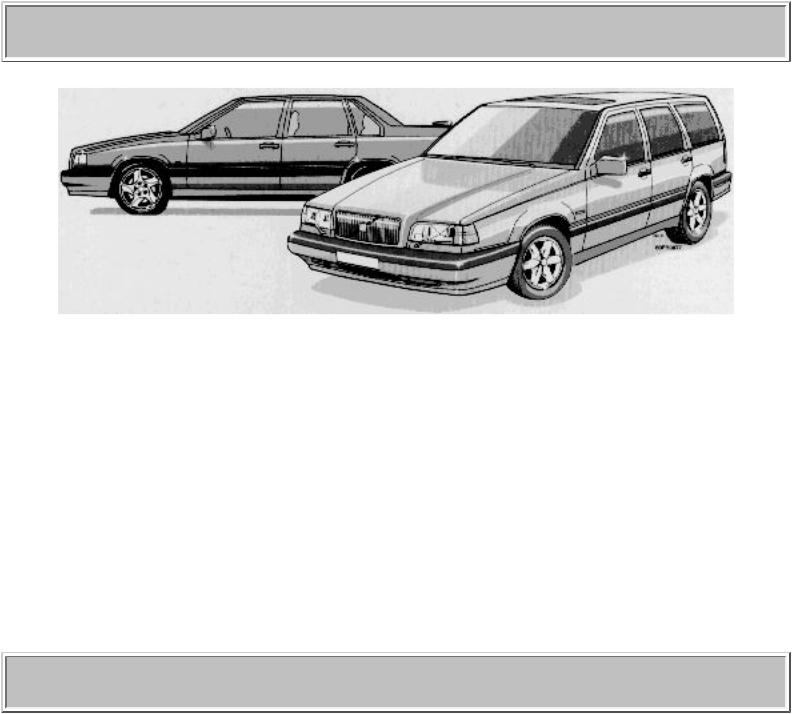
1995 Volvo 850
850 Model
VOLVO 850
1 9 9 5
This manual deals with the operation and care of your Volvo
Welcome to the world-wide family of Volvo owners. We trust that you will enjoy many years of safe driving in your Volvo, an automobile designed with your safety and comfort in mind. To help ensure your satisfaction with this vehicle, we encourage you to familiarize yourself with the equipment descriptions, operating instructions and maintenance requirements/recommendations in this manual. We also urge you and your passengers to wear seat belts at all times in this (or any other) automobile. And, of course, please do not operate a vehicle if you may be affected by alcohol, medication or any impairment that could hinder your ability to drive.
Your Volvo is designed to meet all applicable safety and emission standards, as evidenced by the certification labels attached to the door opening and on the left wheel housing in the engine compartment.
Contents
Important
file:///K|/ownersdocs/1995/1995_850/95850_1.html (1 of 3)12/30/2006 9:53:20 AM

1995 Volvo 850
Before you operate your car for the first time, please familiarize yourself with the BREAK-IN information on page 4:2. You should also be familiar with the information in the first three chapters of this manual.
Information contained in the balance of the manual is extremely useful and should be studied after operating the vehicle for the first time.
This manual is structured so that it can be used for reference. It should thus be kept in the car for ready access.
Do not export your Volvo to another country before investigating the country's applicable safety and exhaust emission requirements. In some cases it may be difficult or impossible to comply with these requirements. Modifications to the emission control system(s) may render your Volvo not certifiable for legal operation in the U.S., Canada and other countries.
All information, illustrations and specifications contained in this manual are based on the latest product information available at the time of publication. Volvo reserves the right to make model changes at any time, or to change specifications or design, without notice and without incurring obligation.
CAUTION: T-5R turbo models have reduced ground clearance due to the design of the front spoiler. Please observe caution when e.g., driving onto garage hoists, through drifted snow or when other road debris is encountered, or when parking near curbs.
Instruments and controls ... 1
Body and interior ... 2
Occupant safety, Reporting Safety Defects ... 3
Starting and driving ... 4
Wheels and tires ... 5
In case of emergency ... 6
Car care ... 7
Service and routine maintenance ... 8
Specifications ... 9
© Volvo Cars of North America
file:///K|/ownersdocs/1995/1995_850/95850_1.html (2 of 3)12/30/2006 9:53:20 AM

1995 Volvo 850
Contents | Top of Page
file:///K|/ownersdocs/1995/1995_850/95850_1.html (3 of 3)12/30/2006 9:53:20 AM
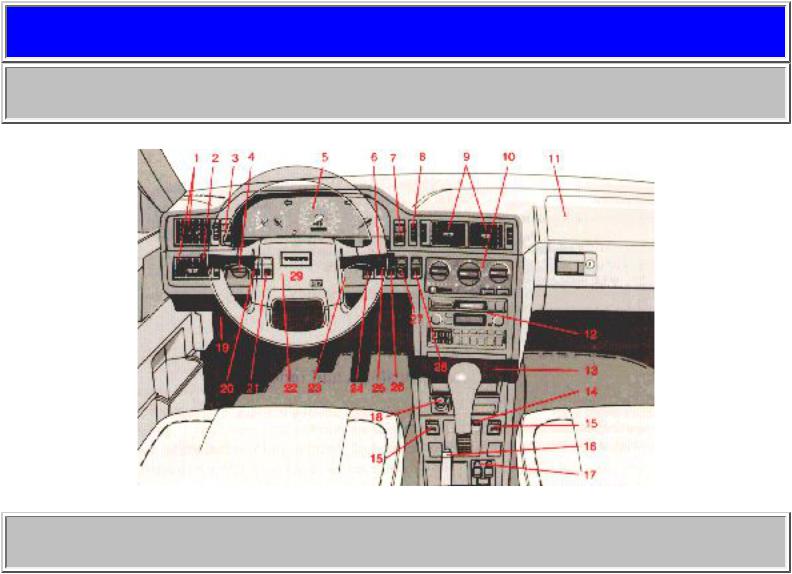
1995 Volvo 850
Instruments and controls
Instruments, switches and controls
pg. 1:1 Instruments, switches and controls (cont.)
IMPORTANT! (Automatic transmission only)
Your car is equipped with a Shiftlock-Keylock system.
SHIFTLOCK:
When your car is parked, the gear selector is locked in the (P)ark position. To release the selector from this position, turn the ignition key to position II (or start the engine), depress the brake pedal, press the button on the front side of the gear selector and move the selector from (P)ark.
If it is necessary to manually override the Shiftlock system, see page 6:17 for instructions.
KEYLOCK
file:///K|/ownersdocs/1995/1995_850/95850_1_1.html (1 of 9)12/30/2006 9:53:21 AM
1995 Volvo 850
This means that when you switch off the ignition, the gear selector must be in the (P)ark position before the starting (ignition) key can be removed from the ignition switch.
ANTI-LOCK BRAKE SYSTEM (ABS)
The ABS system in your car performs a self-diagnostic test when the vehicle first reaches the speed of approximately 20 mph (30 km/h). The brake pedal will pulsate several times and a sound may be audible from the ABS control module. This is normal.
The pages in this section provide detailed descriptions of the vehicle's instruments and controls. Note that vehicles may be equipped differently, depending on special legal requirements.
Page |
|
|
|
1:19 |
1 |
Air vents |
|
1:6 |
2 |
Turn signals, high/low beams |
|
1:15 |
cruise control |
||
1:8 |
3 |
Rear fog light, instrument illumination |
|
1:6 |
4 |
Headlights, parking lights |
|
1:2-1:5 |
5 |
Instruments |
|
1:7 |
6 |
Windshield wiper/washer |
|
1:9 |
7 |
Hazard warning flashers |
|
1:19 |
8 |
Air mix |
|
1:19 |
9 |
Air vents |
|
1:19-1:23 |
10 |
Heating and ventilation controls |
|
3:4, 3:6 |
11 |
Passenger side SRS (air bag) hatch |
|
1:25-1:53 |
12 |
Audio system |
|
1:17 |
13 |
Ash tray |
|
6:17 |
14 |
Shiftlock override button (automatic transmission only) |
|
1:16 |
15 |
Electrically heated front seats (optional) |
|
1:17 |
16 |
Parking brake |
|
1:24 |
17 |
Electrically operated windows |
|
2:7 |
and side door mirrors |
||
file:///K|/ownersdocs/1995/1995_850/95850_1_1.html (2 of 9)12/30/2006 9:53:21 AM
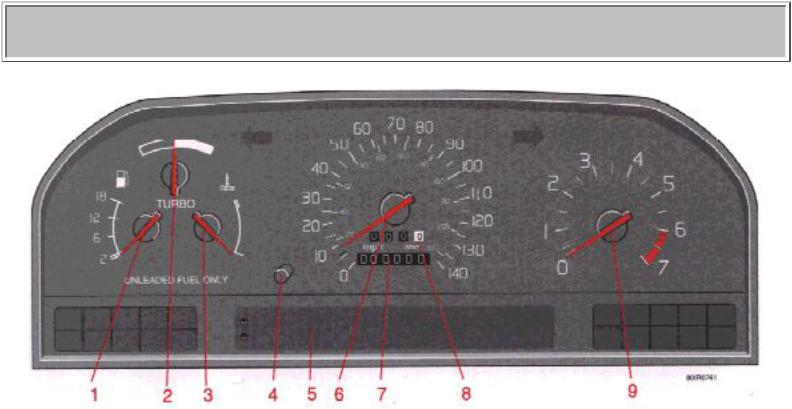
1995 Volvo 850 |
|
|
1:17 |
18 |
Cigarette lighter |
2:10 |
19 |
Hood release |
|
20 |
Front fog lights (optional) |
- |
21 |
Space for additional equipment |
1:18 |
22 |
Adjustable steering wheel |
1:7 |
23 |
Starting (ignition) switch/steering wheel lock |
- |
24 |
Space for additional equipment |
1:3, 1:5, 1:9 25 |
Traction control system (optional) |
|
2:9 |
26 |
Electrically operated sun roof (optional) |
1:12-14 |
27 |
Trip computer (optional) |
1:9 |
28 |
Heated rear window/heated door mirrors |
3:4 |
29 Horn/SRS |
|
Some of the items above are available on certain models only.
pg. 1:2 Instruments
1 Fuel gauge
file:///K|/ownersdocs/1995/1995_850/95850_1_1.html (3 of 9)12/30/2006 9:53:21 AM
1995 Volvo 850
The fuel tank holds approximately 19.3 US gals. (73 liters). When the warning light comes on there is approximately 1.8 US gals. (8 liters) of fuel remaining. See "Refueling" for further information.
2 Boost pressure gauge
(Turbo models only)
The boost pressure gauge is divided into sections. Black section: The engine acts as a normally aspirated engine. Best fuel economy is achieved while driving in this range. White section: The turbocharger provides boost pressure.
3 Temperature gauge
The pointer should be approximately midway on the gauge face when driving. If the pointer approaches the red range repeatedly, check coolant level. Do not drive the car with the pointer in the red range. See "Coolant" section.
4 Trip odometer reset button
5 Clock, ambient temperature sensor (certain models), trip computer (certain models)
6Speedometer
7Odometer
8Trip odometer
Used for measuring shorter distances. The last digit indicates 1/10 mile/kilometer. A black number on a white background = original speedometer. A red number on a white background = replacement speedometer.
9 Tachometer
file:///K|/ownersdocs/1995/1995_850/95850_1_1.html (4 of 9)12/30/2006 9:53:21 AM
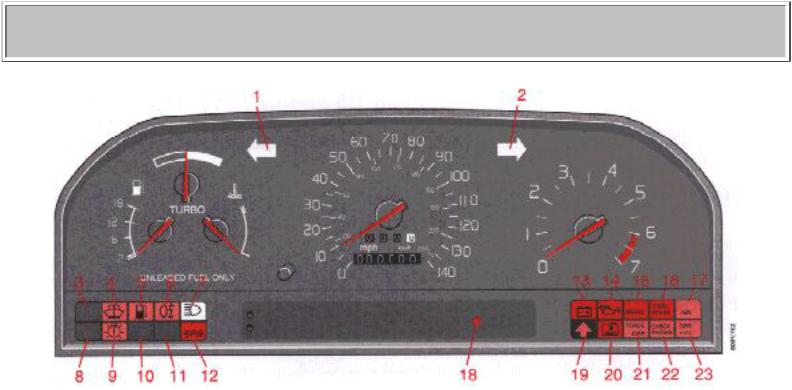
1995 Volvo 850
Reads thousands of engine rpm. The engine should not be operated in the red range.
The highest permitted constant engine speed is 6,300 rpm (turbo-charged models: 6,200 rpm, B 5252 S: 6,000 rpm).
pg. 1:3 Indicator and warning lights
1 Turn signal, left
2 Turn signal , right
3 (Not in use)
4 Low washer fluid level
If the lamp glows continuously when the engine is running, there is only about 1/2 - 1 US qt. remaining in the washer fluid reservoir.
5 Low fuel level
When the lamp glows, only about 1.8 US gals. (8 liters) of fuel remain. 6 Rear fog light
7 High beams
8 (Not in use)
9 Bulb failure warning sensor
10 (Not in use)
11 (Not in use)
12SRS
13Generator not charging
14Low engine oil pressure
15Brake warning light
16Parking brake applied
file:///K|/ownersdocs/1995/1995_850/95850_1_1.html (5 of 9)12/30/2006 9:53:21 AM

1995 Volvo 850
17ABS-system
18Ambient temperature warning light (certain models) (See pp. 1:11 or 1:14 for more information)
19Transmission mode "W", or gear positions 3 or L engaged (automatic transmissions)
20Low coolant level
21Traction Control System (option)
22Malfunction indicator lamp
23Service reminder indicator
pg. 1:4 Warning lights
The warning lights described on pages 1:4 and 1:5 should never stay on when driving
When the ignition key is turned on and before the engine starts, all of the warning lights should be on to test the function of the bulbs. Should a light not go off after the engine has started, the system indicated should be inspected. However, the parking brake reminder light will not go off until the parking brake is fully released.
 Generator warning light
Generator warning light
If the light comes on while the engine is running, check the tension of the generator drive belt as soon as possible.
 Malfunction indicator lamp
Malfunction indicator lamp
If the lamp comes on (or stays on after the vehicle has started), the engine diagnostic system has detected a possible fault in the emission control system. Although driveability may not be affected, see an authorized Volvo dealer as soon as possible for inspection.
 Oil pressure warning light
Oil pressure warning light
file:///K|/ownersdocs/1995/1995_850/95850_1_1.html (6 of 9)12/30/2006 9:53:21 AM

1995 Volvo 850
If the light comes on while driving, the oil pressure is too low. Stop the car and then stop the engine immediately and check the engine oil level. See section "Engine oil". If the light stays on after restart, have the car towed to the nearest authorized Volvo dealer. After hard driving, the light may come on occasionally when the engine is idling. This is normal, provided it goes off when the engine speed is increased.
 Parking brake reminder light
Parking brake reminder light
This light will be on when the parking brake (hand brake) is applied. The parking brake lever is situated between the front seats. Canadian models are equipped with this warning light: 
 Brake fluid warning light
Brake fluid warning light
If the light comes on while driving or braking, this indicates that the brake fluid level is too low. Stop immediately, open the hood and check the brake fluid level in the reservoir (see section "Engine
compartment" for reservoir position)! Canadian models are equipped with this warning light: 
WARNING!
If the fluid level is below the MIN mark in either section of the reservoir: DO NOT DRIVE. Tow the car to a Volvo dealer and have the brake system checked and any leakage repaired.
pg. 1:5 Warning lights (cont.)
 TRACS warning light (option)
TRACS warning light (option)
If this lamp comes on while driving, a fault is indicated in the TRAction Control System. It will also come on if the brakes are overheated and will go out when the brakes have cooled.
If the lamp remains on, the system should be checked by an authorized Volvo dealer. This lamp should not be confused with the ON/OFF indicator lamp above the switch. See page 1:9 for additional information.
file:///K|/ownersdocs/1995/1995_850/95850_1_1.html (7 of 9)12/30/2006 9:53:21 AM
1995 Volvo 850
 Anti-lock Brake System (ABS)
Anti-lock Brake System (ABS)
If the warning lamp lights up there is a malfunction of the ABS system (the standard braking system will however function). The vehicle should be driven to a Volvo dealer for inspection.
See page 4:16 for additional information.
Canadian models are equipped with this warning light: 
 Coolant level sensor
Coolant level sensor
If the light comes on while driving, the coolant level is low. The coolant level in the expansion tank should be checked immediately and topped up if necessary. The cooling system should be inspected by an authorized Volvo dealer.
 Mode "W" engaged
Mode "W" engaged
The lamp will light up when the Winter starting mode is engaged or if gears "3" or "L" are selected. If the warning lamp begins to flash, this means that there is a fault in the automatic gearbox. Contact your Volvo dealer.
 Supplemental Restraint System (SRS)
Supplemental Restraint System (SRS)
If the light comes on (or stays on after the vehicle has started), the SRS diagnostic system has detected a fault. Drive to an authorized Volvo dealer for an inspection of the system. See the SRS section for more information.
 Service reminder indicator
Service reminder indicator
This light will come on at 10,000 mile (16,000 km) intervals*, after 750 hours of driving or after 12 months, whichever occurs first. It is a reminder to the driver that the service interval has been exceeded.
file:///K|/ownersdocs/1995/1995_850/95850_1_1.html (8 of 9)12/30/2006 9:53:21 AM

1995 Volvo 850
The light will stay on for 2 minutes after the start until reset by the servicing dealer.
* Turbo-charged model intervals: 5,000 miles (8,000 km), 500 hours of driving or after 12 months, whichever occurs first.
 Bulb failure warning light
Bulb failure warning light
The light will come on if any of the following bulbs are defective:
●one of the low beam headlights
●one of the tail lights
●one of the brake lights when the brake pedal is depressed.
Check the fuse and bulb. See sections "Replacing bulbs" and "fuses".
Should the warning light come on after a defective outside bulb has been replaced, the corresponding bulb on the other side of the car should also be replaced.
Contents | Top of Page
file:///K|/ownersdocs/1995/1995_850/95850_1_1.html (9 of 9)12/30/2006 9:53:21 AM

1995 Volvo 850
pg. 1:11 Clock, Ambient temperature sensor (certain models)
Resetting the clock
The digital clock can be reset by pressing one of the two buttons (A and B) with a pointed object such as the tip of a pen.
h = hours
m = minutes
Maintain the pressure on the buttons for more than four seconds to change the time more quickly.
Ambient temperature sensor
This sensor indicates the temperature slightly above the road surface. A red warning lamp (C) lights up when the temperature is in the range of 23 - 36° F (-5 - +2° C). Please note that this lamp does not indicate a fault with your car.
At low speeds or when the car is not moving, the temperature readings may be slightly higher than the actual ambient temperature due to the heat generated by the engine.
Display alternatives
If buttons A and B are pressed down simultaneously, it is possible to shift between four different display alternatives, as follows:
Press 1st time: 12 hour clock and °F
Press 2nd time: 24 hour clock and °F
Press 3rd time: 12 hour clock and °C
Press 4th time: 24 hour clock and °C
NOTE: If your battery has been disconnected, the display will default to the 24 hour clock and degrees centigrade.
file:///K|/ownersdocs/1995/1995_850/95850_1_11.html (1 of 10)12/30/2006 9:53:21 AM

1995 Volvo 850
pg. 1:12 Trip computer (certain models)
Trip computer
The trip computer offers six functions which are presented in a single display. The cursor indicates the selected function. The trip computer's clock is shown permanently in the left-hand field. Refer to the previous page for more detailed information regarding the clock function.
The following data is monitored by the computer:
●Average speed
●Current fuel consumption
●Average fuel consumption
●Ambient temperature
●Tripmeter
●Driving distance on current fuel reserve
Warning function
The trip computer is equipped with two warning functions:
●Low fuel level
●Low ambient temperature
If either of these situations occurs, the cursor is activated beside the function affected and in case of low ambient temperature, lamp A also lights up.*
The relevant value is shown in the display, regardless of the function selected. In order to return to the selected function, the control should be rotated one step in either direction and then back again.
NOTE: The low ambient temperature warning always has the highest priority on the display panel. * See page 1:14.
file:///K|/ownersdocs/1995/1995_850/95850_1_11.html (2 of 10)12/30/2006 9:53:21 AM

1995 Volvo 850
Trip computer controls
Select one of the trip computer's six functions by using control B. The Reset button (C) is used to reset the following functions:
●Average speed
●Average fuel consumption
●Trip meter
Rotate the control to the required position and press the button for at least two seconds to reset the selected function.
NOTE: If pressure is maintained on the button for another three seconds, all three of the functions mentioned above will be reset.
pg. 1:13 Trip computer (certain models) (cont.)
Average speed Ø mph (Canada: km/h)
Average speed since the function was last reset. When the ignition is switched off, the average speed is stored in memory and is used as the basis for the new figure when the engine is started again. It can be reset by pressing the reset button on the trip computer control.
Current fuel consumption mpg (Canada: L/100 km)
Continuous information on current fuel consumption, calculated once per second. When the car is not moving, the display shows "---".
file:///K|/ownersdocs/1995/1995_850/95850_1_11.html (3 of 10)12/30/2006 9:53:21 AM
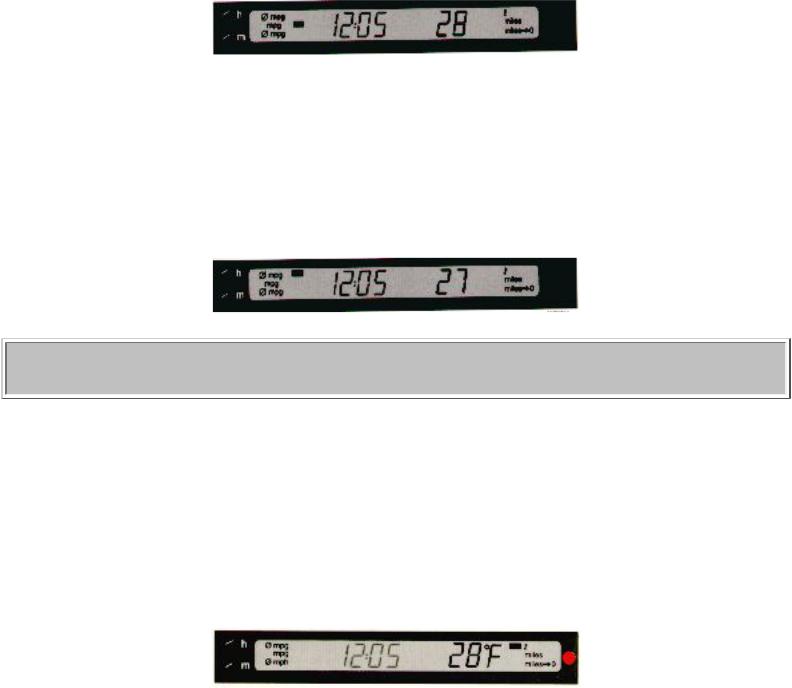
1995 Volvo 850
Average fuel consumption Ø mpg (Canada: L/100 km)
Average fuel consumption since the function was last reset. When the ignition is switched off, the average fuel consumption figure is stored in memory and remains in memory until it is reset using the button on the trip computer control.
pg. 1:14 Trip computer (certain models) (cont.)
Ambient temperature
Shows the ambient temperature just above the road surface while driving. When the temperature is in the range 23 - 36° F (-5 - +2° C), the ambient temperature sensor activates an red warning light. Please note that this lamp does not indicate a fault with your car.
At low speeds or when the car is not moving, the temperature readings may be slightly higher than the actual ambient temperature due to the heat generated by the engine.
Tripmeter in miles (Canada: km)
Shows the distance driven since the function was last reset. This value is stored in memory until it is reset using the reset button on the trip computer control. The trip meter displays 10 yard intervals (Canada: 10 meters) until you have driven 1 mile (Canada: 1 km), after which distance will be measured in miles (km).
file:///K|/ownersdocs/1995/1995_850/95850_1_11.html (4 of 10)12/30/2006 9:53:21 AM

1995 Volvo 850
Driving distance on current fuel reserve mile 0 (Canada: km)
Shows the distance which can be driven on the fuel remaining in the tank, calculated on the basis of the average fuel consumption and the amount of fuel remaining in the tank at the time of the reading. When the quantity of fuel drops to below approximately 1.8 US gals. (8 liters), a warning light in the instrument panel comes on and the cursor beside the "Driving Distance on Current Fuel Reserve" symbol is activated. This takes place regardless of the function currently selected. When the driving distance on the current fuel reserve is less than 5 miles (8 km), the display shows "—".
pg. 1:15 Cruise control
Cruise control
The cruise control switches are located on the turn signal lever.
To engage and set the desired speed:
1.Set switch (B) to ON.
2.Accelerate to the desired cruise speed.
3.Press the + or - area of the SET button (A) to set the desired speed.
file:///K|/ownersdocs/1995/1995_850/95850_1_11.html (5 of 10)12/30/2006 9:53:21 AM

1995 Volvo 850
NOTE: The cruise control cannot be engaged at speeds below 22 mph (35 km).
Braking
This will automatically disengage the cruise control. The previously selected cruise speed is retained in the memory and by momentarily setting the switch to the RESUME position, that speed will be reengaged.
If the cruise control is already engaged, the cruising speed can be increased or decreased by depressing the SET button (A) towards either + or -. One short press on the button corresponds to a speed change of approx. 1 mph (1.6 km/h). When the button is released, the vehicle will maintain the current speed.
If actual speed falls below 70% of the set speed or if the wheels spin or lock, the cruise control will disengage automatically.
NOTE: (AUTOMATIC TRANSMISSION)
When driving up steep hills with the cruise control engaged, the transmission may shift intermittently. This can be avoided by switching between transmission modes E or S while on the hill.
Normally, the ( E )conomy mode should be used when the cruise control is engaged.
Acceleration
Momentary acceleration, such as for passing, does not interrupt cruise control operation. The previously selected speed will be maintained without having to set the switch to RESUME.
To disengage the cruise control system :
Set switch (B) to OFF, depress the brake pedal or move the gear selector to position N. Switching off the starting (ignition) switch will automatically disengage the cruise control system.
On cars equipped with manual transmissions, the cruise control can also be disengaged by depressing the clutch.
WARNING! The cruise control should not be used in heavy traffic or when driving on wet or slippery roads. Do not use or resume cruise control in reverse gear.
file:///K|/ownersdocs/1995/1995_850/95850_1_11.html (6 of 10)12/30/2006 9:53:21 AM

1995 Volvo 850
When the ignition is switched off, any information stored in the cruise control memory is erased.
pg. 1:16 Heated front/rear seats (certain models)
Front seat controls |
Rear seat controls |
Heated front seats
The heated front seats can be switched on and off as required. When switched on, the system senses the ambient temperature and regulates the level of heat applied. When the optimum temperature is reached, the heating switches off automatically. While driving, the seat heating for the passenger seat should be switched off when the seat is not occupied.
Heated rear seats
The rear seat heating can be switched on by pressing the button once. Press the button again to switch the heating off. If the heating is not switched off manually, a timer will automatically turn the system off after 10 minutes. The rear seat heating should be switched off when the seats are not occupied.
NOTE: The rear seat heating connector (located under the seat cushion) must be disconnected before the rear seat cushions can be removed.
pg. 1:17 Parking brake, Cigarette lighter, Ashtrays
file:///K|/ownersdocs/1995/1995_850/95850_1_11.html (7 of 10)12/30/2006 9:53:21 AM
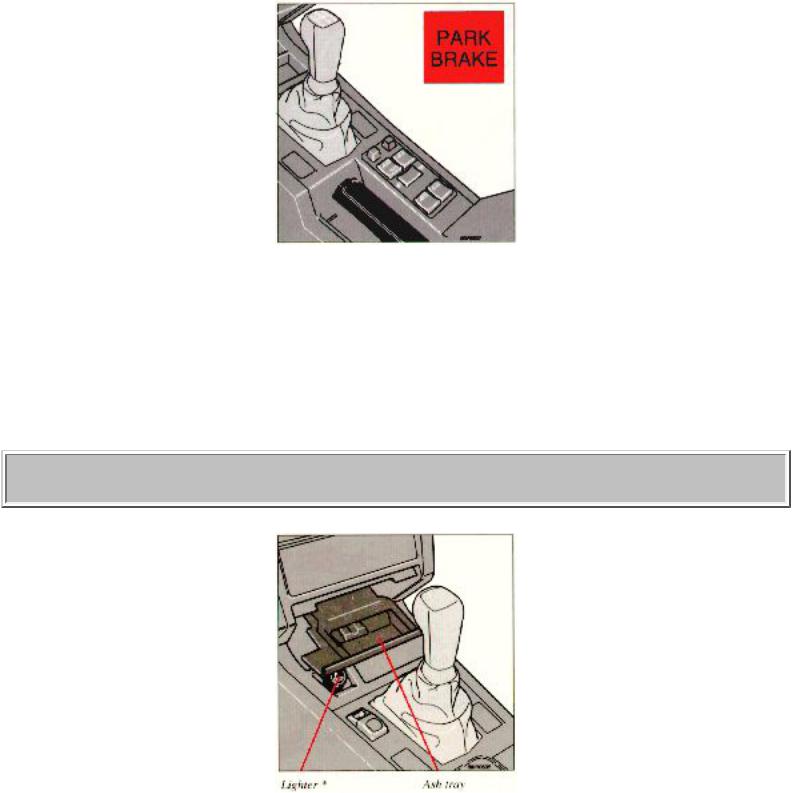
1995 Volvo 850
Parking brake lever
Parking brake (hand brake)
The lever is situated between the front seats. The brake is applied to the rear wheels.
WARNING! Always use the parking brake (hand brake) when parking. On hills, also turn the front wheels toward the curb.
Cigarette lighter
To operate, depress the knob fully. When the knob automatically releases, the cigarette lighter is ready for use.
file:///K|/ownersdocs/1995/1995_850/95850_1_11.html (8 of 10)12/30/2006 9:53:21 AM
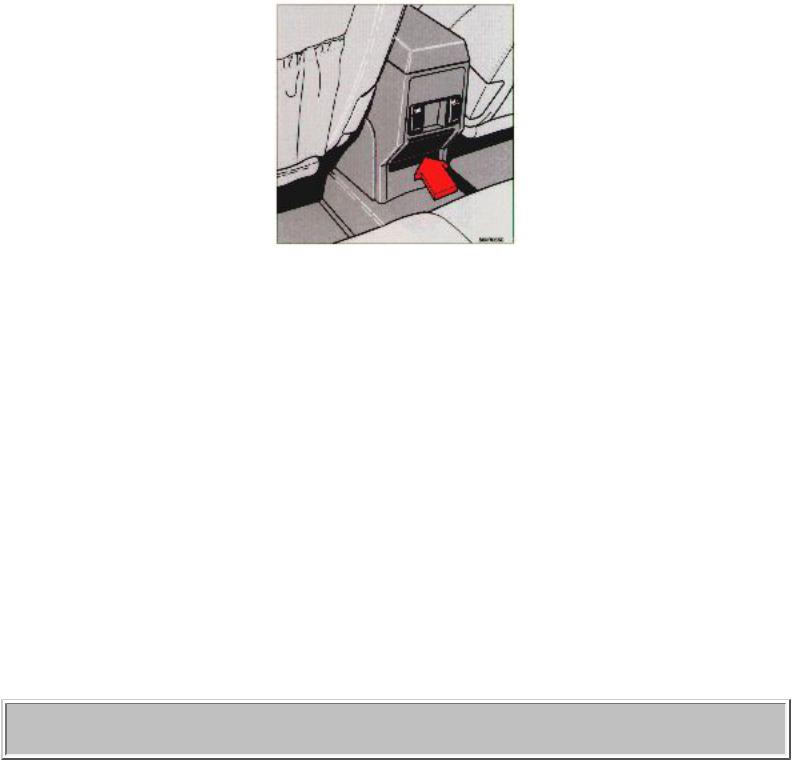
1995 Volvo 850
The starting (ignition) switch must be either in position I or II for the cigarette lighter to function.
* The cigarette lighter is located to the right of the gear shift lever on certain models. This is due to the placement of the "OBD II" terminal, a diagnostic connector intended for use by authorized service technicians only.
Rear ash tray
Ash trays
To open the front ash tray, press lightly on the panel.
To open the rear ash tray, pull it straight out.
To empty the front ash tray (see illustration, center column):
(1)Grasp the removable gray insert on the sides and push it in.
(2)Pull the insert straight up.
Only this insert can be removed for cleaning.
To empty the rear ash tray, pull it out, lift up the rear edge and remove.
pg. 1:18 Steering wheel adjustment
file:///K|/ownersdocs/1995/1995_850/95850_1_11.html (9 of 10)12/30/2006 9:53:21 AM
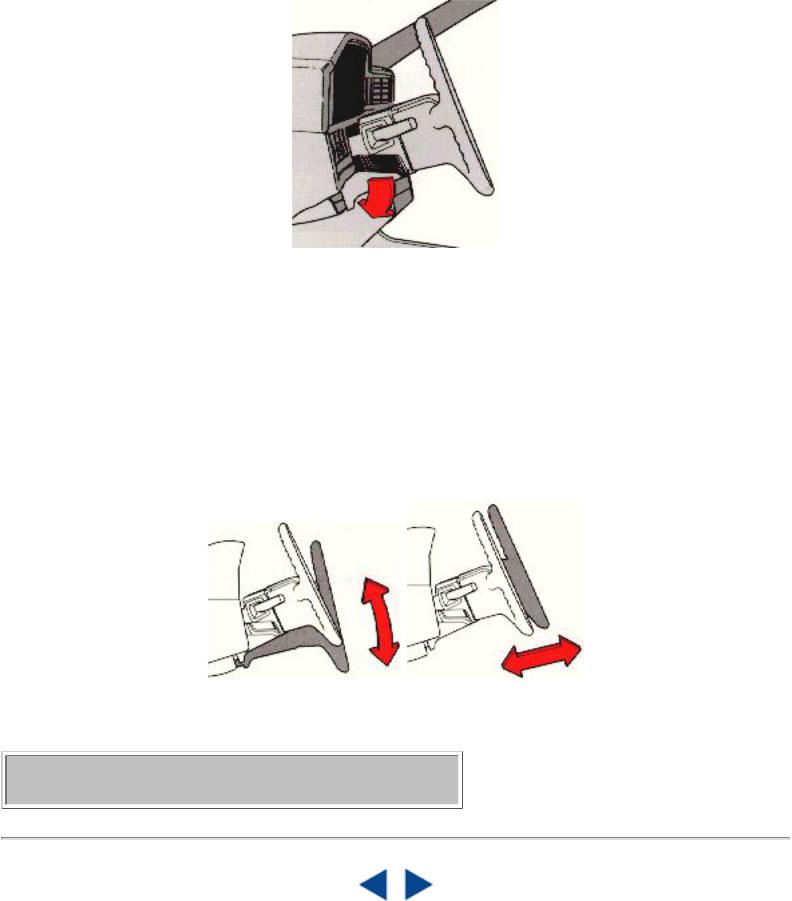
1995 Volvo 850
Depress...
Steering wheel adjustment
Both the height and the reach of the steering wheel can be adjusted to a comfortable position for the driver. Press down the lever on the left of the steering column. Adjust the steering wheel to a suitable position and press the lever back into place to lock the steering wheel in the new position. Check that the steering wheel is locked in the new position.
... to adjust height |
...to adjust length |
WARNING! Never adjust the steering wheel while driving.
Contents | Top of Page
file:///K|/ownersdocs/1995/1995_850/95850_1_11.html (10 of 10)12/30/2006 9:53:21 AM
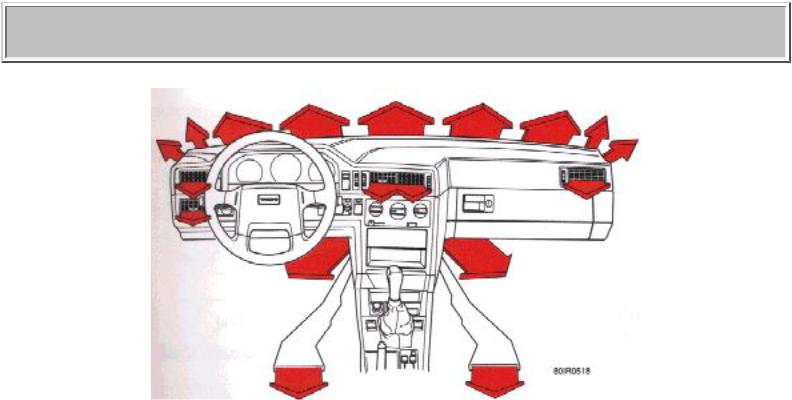
1995 Volvo 850
pg. 1:19 Heating, ventilation and air conditioning
Heating and air conditioning
Your Volvo is equipped with a heating system combined with air conditioning. Depending on which function you select, warm or cool/cold air is distributed to the different parts of the passenger compartment. A slight amount of condensation may be emitted from the air vents when the air conditioning is initially switched on. This can occur when both humidity and ambient temperature are high and is normal.
Refrigerant
The air conditioning system in your car contains a CFC-free refrigerant - R134a. This substance will not deplete the ozone layer. Volvo cares about the environment. The system contains 1.65 lbs (0.75 kg) R134a and uses ZXL 100PG (type PAG) oil.
file:///K|/ownersdocs/1995/1995_850/95850_1_19.html (1 of 10)12/30/2006 9:53:22 AM

1995 Volvo 850
Air vents (dash)
AClosed
BOpen
CDirecting air flow horizontally
DDirecting air flow vertically
Air mix
The center panel vents have an air mix function which allows fresh air to enter the passenger compartment when the vents are open (position B). This function is designed to allow you to direct cool air toward your face while directing warmer air to the rest of the passenger compartment.
To warm the compartment as quickly as possible, the air mix control should be in the closed position.
pg. 1:20 Heating, ventilation and air conditioning (standard unit)
file:///K|/ownersdocs/1995/1995_850/95850_1_19.html (2 of 10)12/30/2006 9:53:22 AM
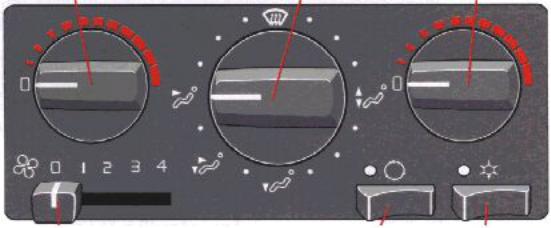
1995 Volvo 850
Temperature dial
Driver's side
Set desired temperature
Function selector
Set desired function
Temperature dial
Passenger's side
Set desired temperature
Blower
0 = Blower (and A/C) off
4 = Highest blower speed
 Air in the passenger compartment recirculates - will not function in defrost setting. The light is ON when the function is engaged.
Air in the passenger compartment recirculates - will not function in defrost setting. The light is ON when the function is engaged.
 The A/C system is ON when the light is ON.
The A/C system is ON when the light is ON.
Function selector
file:///K|/ownersdocs/1995/1995_850/95850_1_19.html (3 of 10)12/30/2006 9:53:22 AM
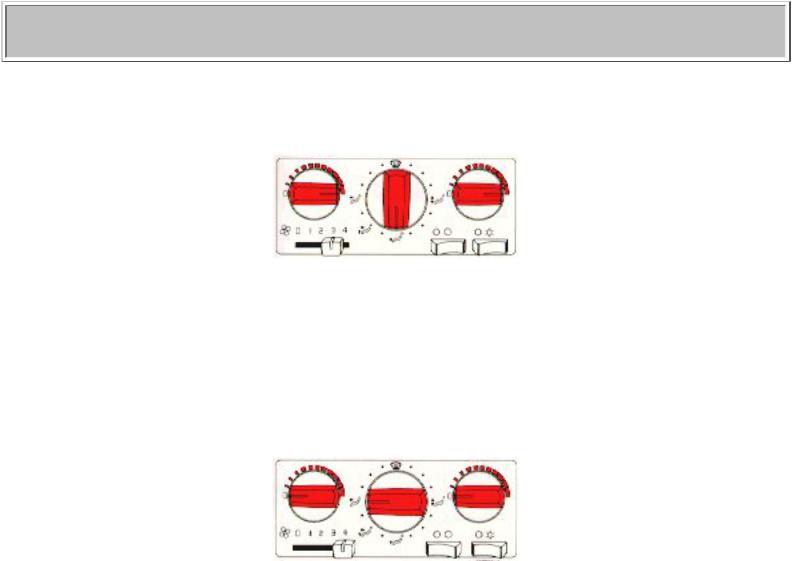
1995 Volvo 850
 Air through panel vents
Air through panel vents
 Defrost. Air to windshield and side windows.
Defrost. Air to windshield and side windows.
 Air to floor, windshield and side windows.
Air to floor, windshield and side windows.
 Air through floor vents.
Air through floor vents.
 Bi-level. Air through floor and panel vents.
Bi-level. Air through floor and panel vents.
pg. 1:21 Heating, ventilation and air conditioning (standard unit) (cont.)
Maximum heating:
Close the center panel vents. When the passenger compartment has become sufficiently warm, set the blower control to position 2, adjust the temperature and open the side air vents.
Maximum cooling:
Open the vents. The A/C system should be ON.
Adjust the temperature with the temperature selectors to raise the temperature if necessary.
To demist/defrost the windows:
file:///K|/ownersdocs/1995/1995_850/95850_1_19.html (4 of 10)12/30/2006 9:53:22 AM

1995 Volvo 850
Set the function selector to  . When the windows have cleared, set the blower control to position 2 and the function selector to the desired position. Always keep the air intake grille at the base of the windshield under the rear edge of the hood free of snow.
. When the windows have cleared, set the blower control to position 2 and the function selector to the desired position. Always keep the air intake grille at the base of the windshield under the rear edge of the hood free of snow.
Additional information
●The air conditioning system will function best if used regularly (at least once a month).
●Water under the vehicle in hot weather can be the result of condensation from the air conditioning system and is quite normal.
●The air conditioning system functions only at temperatures above 32° F (0° C).
● Choose this position if the outside air is contaminated with exhaust gases, smoke, etc. or to heat/ cool the car quickly. In this position, very little air is drawn into the passenger compartment from the outside. Do not leave the system in this mode for more than 10-15 minutes since the air inside the car will become stale. The temperature can be controlled with the temperature selectors.
Choose this position if the outside air is contaminated with exhaust gases, smoke, etc. or to heat/ cool the car quickly. In this position, very little air is drawn into the passenger compartment from the outside. Do not leave the system in this mode for more than 10-15 minutes since the air inside the car will become stale. The temperature can be controlled with the temperature selectors.
●If the panel vents are open, a certain amount of air will always flow through, regardless of the position the function selector is in. To increase the flow of air to either the floor or the windows, close the panel vents. The outer vents can be opened to avoid mist on the side windows.
●The panel vents may emit some condensation when the air conditioning is initially switched on and is quite normal. This may occur if the ambient temperature and humidity are high.
●The air conditioning is momentarily disengaged during full-throttle acceleration.
pg. 1:22 Heating, ventilation and air conditioning (Electronic Climate Control) - option
file:///K|/ownersdocs/1995/1995_850/95850_1_19.html (5 of 10)12/30/2006 9:53:22 AM
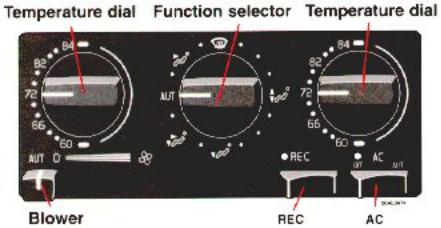
1995 Volvo 850
Temperature dial
Driver's side
Set desired temperature
Function selector
Set desired function
Temperature dial
Passenger's side
Set desired temperature
Blower
AUT=Blower speed automatically regulated. 0 = OFF
Move the knob to the right to increase blower speed.
REC
Air in the passenger compartment recirculates - will not function in defrost setting. The light is ON when the function is engaged.
AC
The light ON indicates that the A/C is OFF. When the function selector is in the defrost setting, the A/C system is ON regardless of the button position. The button must be in the AUT position for cooling.
Function selector
file:///K|/ownersdocs/1995/1995_850/95850_1_19.html (6 of 10)12/30/2006 9:53:22 AM
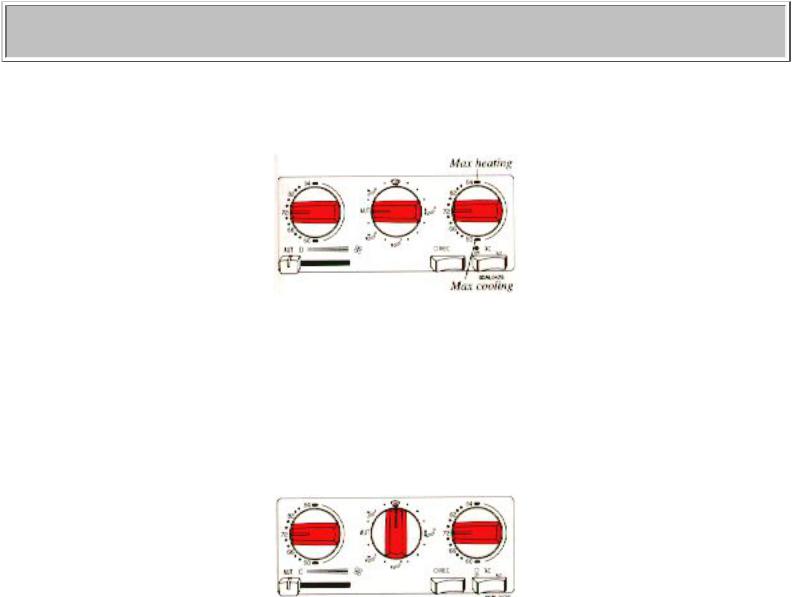
1995 Volvo 850
AUT Air distribution automatically regulated  Air through panel vents
Air through panel vents
 Defrost. Air to windshield and side windows. Recirculation will not function regardless of button position.
Defrost. Air to windshield and side windows. Recirculation will not function regardless of button position.
 Air to floor, windshield and side windows.
Air to floor, windshield and side windows.
 Air through floor vents.
Air through floor vents.
 Bi-level. Air through floor and panel vents.
Bi-level. Air through floor and panel vents.
pg. 1:23 Heating, ventilation and air conditioning (Electronic Climate Control) - option (cont.)
Automatic setting
Set the mode selector to AUT and select the desired temperature. If the driver's side temperature selector is set to either the max heating or max cooling position, the blower will run at its maximum speed.
Optimum defrosting
Set the function selector to  and move the blower control to the position AUT (as far to the left as
and move the blower control to the position AUT (as far to the left as
file:///K|/ownersdocs/1995/1995_850/95850_1_19.html (7 of 10)12/30/2006 9:53:22 AM
1995 Volvo 850
possible). The A/C system will be on at this time regardless of the A/C button's position and the blower will run at its maximum speed. When the windows have cleared, set the function selector in the AUT position.
Additional information
●The air conditioning system will function best if used regularly (at least once a month).
●Always keep the air intake grille at the base of the windshield under the rear edge of the hood free of snow.
●Water under the vehicle in hot weather can be the result of condensation from the air conditioning system and is quite normal.
●The air conditioning is disengaged when the blower is set at 0 and the speed of the vehicle is less than 20 mph (30 km/h).
●The air conditioning system functions only at temperatures above 32° F (0° C).
●Recirculation (REC): Choose this position if the outside air is contaminated with exhaust gases, smoke, etc. or to heat/cool the car quickly. In this position, very little air is drawn into the passenger compartment from the outside. Do not leave the system in this mode for more than 10-15 minutes since the air inside the car will become stale and condensation will form on the windows.
NOTE: To help maintain stable passenger compartment temperature when driving with the sun roof or windows open, place the blower control in position "0" and adjust the desired temperature manually.
●If the panel vents are open, a certain amount of air will always flow through, regardless of the position the function dial is in. To increase the flow of air to either the floor or the windows, close the panel vents. The outer vents can be opened to avoid mist on the side windows.
●The panel vents may emit some condensation when the air conditioning is initially switched on and is quite normal.
This may occur if the ambient temperature and humidity are high.
●The sunlight sensor (located at the top center of the dashboard) should not be covered in any way as this could cause incorrect information to be sent to the ECC system.
●The air conditioning is momentarily disengaged during full-throttle acceleration.
Faults in the ECC system
The REC and AC OFF lights will flash for approximately 20 seconds if a fault is detected in the ECC system.
If this flashing recurs the next time the system is switched on, the climate control unit should be checked
file:///K|/ownersdocs/1995/1995_850/95850_1_19.html (8 of 10)12/30/2006 9:53:22 AM
